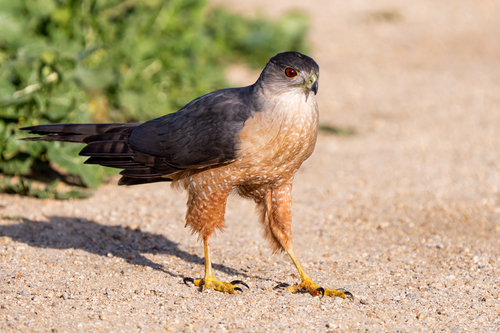
Cooper's Hawk
The Cooper's Hawk (Accipiter cooperii) is a medium-sized hawk native to North America, renowned for its agility and hunting prowess in wooded habitats. It plays a crucial role in the ecosystem as a predator of small birds and mammals, helping to regulate their populations. It is a member of the Accipitridae family, which includes hawks, eagles, and kites. While not holding significant cultural importance compared to some raptors, its recovery from population declines in the mid-20th century is a conservation success story.
35-50 cm
Length
62-94 cm
Wingspan
Least Concern
Conservation Status
Distribution
Cooper's Hawks are found throughout North America, from southern Canada to northern Mexico. They breed across much of the United States and southern Canada. During winter, northern populations migrate south, some reaching as far as Central America. They have a broad altitudinal range, occurring from sea level to mountainous regions.
Lifespan
Up to 12 years in the wild; longer in captivity (though data is limited).
Cooper's Hawk's Habitat
Habitat Types
Deciduous forests, Mixed woodlands, Riparian woodlands, Open woodlands with scattered trees, Suburban and urban areas with sufficient tree cover
Climate Zones
Temperate, Subtropical
Adaptations
Their short, rounded wings and long tail provide exceptional maneuverability for navigating dense vegetation while pursuing prey.
Variations
While subtle, some regional variations in size and plumage coloration exist, though no formally recognized subspecies are widely accepted.
Appearance
Breeding Plumage
Adult plumage is similar year-round.
Seasonal Feather Changes
No significant seasonal variations, although plumage may appear more worn in late summer.
Sex Based Plumage Differences
Adult males have a blue-gray back and reddish-orange barring on the breast. Females have a browner back and less distinct barring. Juveniles have brown upperparts and streaked underparts.
Notable Features
Long, rudder-like tail with dark bands., Short, rounded wings., Red eyes in adults (yellow in juveniles)., Sharp, hooked beak for tearing prey.
Diet and Feeding
Primary Foods
Small birds (e.g., robins, starlings, doves), Small mammals (e.g., chipmunks, mice, squirrels), Occasionally reptiles and amphibians
Foraging Behavior
Cooper's Hawks are skilled aerial hunters, often using a combination of stealth and speed. They may perch and wait for prey or fly low through vegetation, using surprise attacks. They are also known to pursue prey on foot.
Specializations
Their agility and speed are key specializations, allowing them to capture fast-moving prey in cluttered environments.
Seasonal Diet Variations
Diet may shift slightly depending on prey availability. For example, they may take more mammals during winter when some bird species have migrated.
Behavior
Social Structure
Generally solitary or found in pairs during the breeding season. They may form small, loose flocks during migration.
Communication
A series of 'cak-cak-cak' calls, often used during alarm or courtship., Whistles and other vocalizations., Visual displays, such as spreading their tail feathers.
Migration
Northern populations are migratory, moving south for the winter. Southern populations may be resident year-round. Migration routes and timing vary depending on geographic location.
Territorial or Group Behaviors
Cooper's Hawks are territorial during the breeding season, defending their nesting area from other hawks and potential predators. They become less territorial outside breeding season.
Conservation
Threats
Habitat loss and fragmentation, Collisions with windows and vehicles, Exposure to pesticides (though less of a threat now than in the past), Climate change (potential impacts on prey availability and habitat)
Protection Programs
Migratory Bird Treaty Act (in the US), Various state and provincial wildlife regulations, Habitat conservation efforts by organizations like The Nature Conservancy
Local National Laws
Protected under the Migratory Bird Treaty Act in the United States, Canada, and Mexico.
Population Trend
Increasing
Population Estimates
Global population estimated to be over 1 million individuals.
Interesting Facts
They are named after the naturalist William Cooper.
William Cooper was one of the founders of the New York Lyceum of Natural History (now the New York Academy of Sciences).
They are sometimes called "chicken hawks," although they rarely prey on chickens.
This misnomer likely arose from their occasional predation on small poultry, but their primary diet consists of wild birds and mammals.
Cooper's Hawks can catch birds in mid-flight.
Their exceptional agility and speed make them highly effective aerial predators.
Females are larger than males, a common trait in raptors.
Called 'reverse sexual dimorphism', it is thought to be due to several factors such as allowing them to incubate large clutches and subdue larger prey
Faqs about Cooper's Hawk
What should I do if I find an injured Cooper's Hawk?
Contact a local wildlife rehabilitator or veterinarian. Do not attempt to handle the bird yourself, as they have sharp talons and beaks. *Consult a professional for expert advice.*
Are Cooper's Hawks dangerous to humans?
No, Cooper's Hawks are not typically aggressive towards humans unless their nest is threatened. It is best to observe them from a distance.
How can I attract Cooper's Hawks to my backyard?
While you may not want to attract them directly (as they prey on songbirds), providing a natural habitat with trees and shrubs can make your yard more appealing to a variety of bird species, including Cooper's Hawks.
Do Cooper's Hawks mate for life?
Cooper's Hawks are thought to be mostly monogamous, often pairing with the same mate for several years. However, 'divorce' can occur, and they may find a new mate if their previous partner dies.
Copyright @ Nature Style Limited. All Rights Reserved.
 English
English